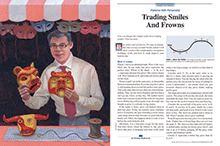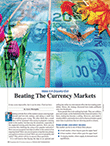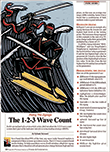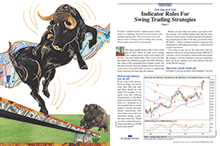LETTERS TO THE EDITOR
November 2013 Letters To The Editor
The editors of S&C invite readers to submit their opinions
and information on subjects relating to technical analysis and this magazine.
This column is our means of communication with our readers. Is there something
you would like to know more (or less) about? Tell us about it. Without a source
of new ideas and subjects coming from our readers, this magazine would not
exist.
Address your correspondence to: Editor, Stocks & Commodities,
4757 California Ave. SW, Seattle, WA 98116-4499, or E-mail to editor@traders.com.
All letters become the property of Technical Analysis, Inc. Letter-writers
must include their full name and address for verification. Letters may
be edited for length or clarity. The opinions expressed in this column do not
necessarily represent those of the magazine. —Editor
SMILES AND FROWNS
 Editor,
Editor,
I enjoyed Tom Bulkowski’s article “Trading Smiles And Frowns” (S&C, October 2013 issue). I am uncertain of why he offset the 50-day moving average by 25 days. Could you explain why and also, what is meant by the term offset? If this explanation lies in one of Bulkowski’s books, I would look to that.
Rsafanda
Author Tom Bulkowski replies:
This concept is discussed further in my book Swing And Day Trading. Using a moving average helps you visualize the smile or frown. It has no trading significance.
As my October 2013 S&C article explains, you can push (offset) the moving average to the left to help line it up with price so that the smile or frown becomes obvious. To do this, use half the wavelength of the moving average. For example, if you’re using a 200-day moving average, then you would push it to the left by half that, or 100 days. That “offset” will properly line it up with price.
KEEP YOUR PORTFOLIO SAFE
Editor,
Azeez Mustapha’s August 2013 S&C article “Keep Your Portfolio Safe” has many gems of wisdom. It’s worth reading again and again.
Sudarshan Sukhani
BEATING THE CURRENCY MARKETS
 Editor,
Editor,
I enjoyed Azeez Mustapha’s “Beating The Currency Markets” in the September 2013 S&C. I have implemented it in NinjaTrader.
Personally, I would not be so rigid on the -100 stop-loss and the +200 exit, or even the 10-day exit. Nevertheless, it’s an excellent article.
Mario Fernandes
NINJASCRIPT FOR SWING TRADING STRATEGY
Editor,
I have a couple of questions in regard to Sylvain Vervoort’s article in the May 2013 S&C, “Indicator Rules For Swing Trading Strategies, Part 1.”
- Can these rules be used for commodities and forex along with stocks?
- Where can I get the programming code to put these indicators into a trading program? If I’m using NinjaTrader or TD Ameritrade (thinkorswim) platforms, will all the programming code for all the indicators be available so I can just add them to NinjaTrader?
I also was looking to purchase Vervoort’s book Capturing Profit With Technical Analysis.
Eric Zwinski
Sylvain Vervoort replies:
In regard to your first question on what markets this technique can be used on: You can use it on anything that makes moves suitable for swing trading — meaning regular and large-enough moves.
As to your second question, the programming code I have used for my article series is NinjaScript for NinjaTrader, and I will be offering downloadable .zip files at my website, https://stocata.org. The code is also available for subscribers as text at the STOCKS & COMMODITIES website, www.traders.com, in the Article Code area. Code for other platforms is available in the Traders’ Tips section of the STOCKS & COMMODITIES website, www.traders.com.
1-2-3 WAVE COUNT
Editor,
I read with interest Sylvain Vervoort’s article series beginning with the May 2013 issue of STOCKS & COMMODITIES (“Indicator Rules For Swing Trading Strategies, Part 1”). Regarding the 1-2-3 wave count, can this be applied to time frames lower than daily charts?
I was wondering if I can use it for intraday trading the emini S&P.
SSChiu
Author Sylvain Vervoort replies:
Depending of what the underlying instrument is and the time frame used, you will have to adapt the wave count settings.
For the most part, you can use this swing trading technique with any instrument or time frame, even on renko bars or ranges not related to time. But remember that the 1-2-3 wave count is just part of my system and not meant to be used alone to trade. I have outlined other components of my technique in my other articles in this series.
If you use wave counts on their own, you should run backtests first to make sure of the settings that tend to be profitable. I did some testing myself, and I generally found it to be profitable. However, using my complete set of rules (indicator rules for a swing trading strategy, or IRSTS) will help to avoid some of the losing trades, obtaining a better final result.
SWING TRADING STRATEGY FOR EXCEL
 Editor,
Editor,
I am enjoying reading Sylvain Vervoort’s current series of articles in
your magazine on indicator rules for a swing trading strategy. I’m
working to put his step candle pattern logic into spreadsheet form so I can incorporate
the logic into my spreadsheet trading system (see Excel
listing following this letter). Vervoort’s
article gave me the motivation to develop the logic to implement his candlestick
patterns at peaks & valleys. The system should work intraday, and, utilizing
a minimum percent swing, could properly identify a trend in progress between
apexes with daily zigzag patterns.
I find that Elliott waves are too subjective and require too much logic to try to implement. I really believe that all the best trading rules can be found and implemented from Arthur Merrill’s work on MW waves logic (Filtered Waves, Basic Theory, 1977), along with understanding cycles as those clearly defined by JM Hurst (Profit Magic Of Stock Transaction Timing, 1970). What these two technicians missed are the more exact turning points, or the identification of peaks & valleys, for time frames longer than intraday. Back in their day, swing trading could be done easily with daily bars, but today, with a large percentage of the market dominated by computer logic making millisecond decisions, we little guys need to look at intraday data to make a profit. Vervoort’s work shed light on that part of it, so thank you to him!
The two key things that need to be defined properly, as anyone who has looked into this knows, are:
- How to quickly and accurately identify turning points (peaks/valleys) in any time frame
- How to quickly and accurately identify when we’re in a trend with noise as opposed to being in a peak/valley in any time frame.
Please don’t neglect spreadsheet logic in your articles and website; many of us trade using sheets and enter trades on websites for IRAs, 401ks, and so on, with daily and intraday data. Swing trading is alive and well outside of brokerages and systems supplied by trading houses! Commissions, for Rydex, for example, are embedded in their trades, so the leveraged funds they trade are computed to over/undershoot, by a little, the target price of the underlying, giving them their profit and me my leveraged trade, usually to the nearest penny. So I can effectively trade without commissions or taxes (especially in Roth IRAs).
I like Vervoort’s style and directness. I would ask him to consider preparing spreadsheet logic in the future. I think many readers would respond to this, since then they can buy and try directly, without needing to use a canned system from someone else.
I am looking over Vervoort’s collection of published books and will probably buy one or more of them soon.
Don
STEP CANDLE PATTERN LOGIC IN SPREADSHEET FORM (SUBMITTED
BY READER)
Variables;
OHLC, Open, High, Low, Close - Normal data values
UDS Up, Down Step
+2 is Up, Up
+1 is Dn, Up
-2 is Dn, Dn
-1 is Up, Dn
0 is No Step Identified
UDG Up, Down, Step, Gap
All the UDS values plus
+4 is +2 Gap Up
+3 is +1 Gap Up
-4 is -2 Gap Dn
-3 is -1 Gap Dn
PV Identified Peak/Valley H/L
C means current bar, C(1) means last bar
UDS:
=IF(AND(C(1)>O(1),C>O,C>C(1),O>O(1)),2, up, up,
candle body up
IF(AND(C(1)O,C>O(1),O>O(1)),1,
dn, up, candle body up
IF(AND(C(1)=O(1),CC(1)),+4, +2 and gap up
IF(AND(UDS=1,O>O(1)),+3, +1 and gap up
IF(AND(UDS=-2,O<=L(1),UDG<0),MAX(H,H(1)), if lower low and down, set peak =
highest high
IF(AND(H>=H(1),UDG>0),MIN(L,L(1)),PV(1)))
if higher high and up, set valley = lowest low
Author Sylvain Vervoort replies:
Thanks very much for your letter and for the information. Personally, I switched to NinjaTrader from another program because I want to go for autotrading as much as possible. This is working fine (though not perfect yet) with NinjaTrader and C# programming.
Since I still have much to learn in NinjaScript and C# programming, I have to limit my time spent in other applications/programming languages, which is why I don’t also provide code for Excel. But it’s nice to hear that you are implementing it in spreadsheet logic form.
In addition, please note that Excel code is regularly included in this magazine’s Traders’ Tips section each month submitted by freelance Excel programmer Ron McAllister, and recent Traders’ Tips sections have focused on my recent article series.
HALL OF FAME AWARD GOES TO S&C’S PUBLISHER
Jack K. Hutson
We are happy to announce that the publisher of Technical Analysis of STOCKS & COMMODITIES magazine, Jack K. Hutson, was the recipient of the 2013 Traders’ Library Hall Of Fame Award on September 14, 2013, recognized for his ongoing contribution to trading education through this magazine. Traders’ Library is a retailer of books on trading. Hutson launched STOCKS & COMMODITIES magazine in 1982 to provide an exchange of information on technical analysis.
Originally published in the November 2013 issue of Technical Analysis of Stocks & Commodities magazine. All rights reserved. © Copyright 2013, Technical Analysis, Inc.
Return to
Contents
 Editor,
Editor, Editor,
Editor,
 Editor,
Editor,